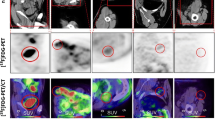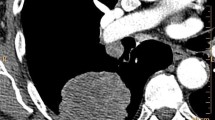Abstract
Following treatment of mediastinal Hodgkin's disease (HD), residual masses are frequent and gallium scanning has proven to be of value in the evaluation of their specificity (fibrosis or active disease). This study assessed, for relapse and survival, the predictive value of restaging gallium scan of patients with a residual mass on computed tomography scan after induction chemotherapy. Between 1/89 and 12/97, in 53 newly diagnosed HD patients with a residual mediastinal mass, a gallium scan was performed after chemotherapy (3 or 4 courses) and always before consolidative radiotherapy. Characteristics at diagnosis were: nodular sclerosis histology, 89%; bulky mediastinal disease, 79%; B-symptoms, 51%. Results: gallium scan was positive in 16 patients (30%) and negative in 37 (70%). At median follow-up period of 36 months, freedom-from-progression rate was 86% versus 19% (P<0.0001) for patients with negativevs positive gallium scans, respectively. The 5-year overall survival (OS) rate was 68% and differed significantly (P<0.0001) between negative (91%) and positive (25%) gallium scanning groups. The specificity of gallium scanning was 91% and the sensitivity 72% with a positive predictive value of 81% and a negative predictive value of 86%. Evaluation with gallium scan after induction chemotherapy identifies chemosensitive patients among those with poorprognosis mediastinal HD. Although relapse may occur in patients with negative gallium scan, a postive gallium scan is highly predictive of failure and poor outcome, and treatment should thus be modified.
Similar content being viewed by others
References
Carde Pet al. Clinical stages I and II Hodgkin's disease a specifically tailored therapy according to prognostic factors.J Clin Oncol 1988;6: 239–252.
Strauss DJet al. Prognostic factors among 185 adults with newly diagnosed advanced Hodgkin's disease treated with alternating potentially noncross resistant chemotherapy and intermediate-dose radiotherapy.J. Clin Oncol 1990;8: 1173–1186.
Israel Oet al. Gallium-67 imaging in monitoring lymphoma response to treatment.Cancer 1988;61: 2439–2443.
Kostakoglu Let al. Validation of gallium-67-citrate single photon emission computed tomography in biopsy-confirmed residual Hodgkin's disease in the mediastinum.J Nucl Med 1992;33: 345–350.
McLaughlin AF, Southee AE. Gallium scintigraphy in tumor diagnosis and management. In: IPC Murray, PJ EII (eds.).Nuclear Medicine in Clinical Diagnosis and Treatment, vol. 2. Churchill Livingstone: Edinburgh, 1994, pp 711–725.
Wylie BRet al. Gallium scanning in the management of mediastinal Hodgkin's disease.Eur J Haematol 1989;42: 344–347.
Southee AEet al. Gallium scanning as a predictor of outcome in mediastinal Hodgkin's disease.Eur J Nucl Med 1989;15: 547–551.
Kaplan WDet al. Gallium-67 imaging: a predictor of residual tumor viability and clinical outcome in patients with diffuse large-cell lymphoma.J Clin Oncol 1990;8: 1966–1970.
Front D, Israel O. The role of Ga-67 scintigraphy in evaluating the results of therapy of lymphoma patients.Semin Nucl Med 1995;25: 60–71.
King SC, Reiman RJ, Prosnitz LR. Prognostic importance of restaging gallium scans following induction chemotherapy for advanced Hodgkin's disease.J Clin Oncol 1994;12: 306–3111.
Hagemeister FBet al. The gallium scan predicts relapse in patients with Hodgkin's disease treated with combined modality therapy.Ann Oncol 1994;5(Suppl 2): 59–63.
Janicek Met al. Early restaging gallium scans predict outcome in poor-prognosis patients with aggressive non-Hodgkin's lymphoma treated with high-dose CHOP chemotherapy.J Clin Oncol 1997;15: 1631–1637.
Tumeh SSet al. Lymphoma: evaluation with Ga-67 SPECT.Radiology 1987;164: 111–114.
Brice Pet al. Residual mediastinal mass in malignant lymphoma: value of magnetic resonance imaging and gallium scan.Nouv Rev Fr Hematol 1993;35: 457–451.
Hubner KF, Buonocore E, Singh SK, Gould HR, Cotten DW. Characteriation of chest masses by FDG positron emission tomography.Clin Nucl Med 1995;20: 293–298.
Hasenclever D, Diehl V. A prognostic score for advanced Hodgkin's disease.N Engl J Med 1998;339: 1506–1514.
Cheson BDet al. Report of an international workshop to standardize response criteria for non Hodgkin's lymphomas.J Clin Oncol 1999;17: 1244–1253.
Kaplan ES, Meier P. Non parametric estimation from incomplete observations.J Am Stat Assoc 1958;53: 457–461.
Andre Met al. Results of 3 courses of ABVD with subtotal nodal irradiation in 189 patients with nodal Hodgkin's disease (stage I, II, IIA).Hematol Cell Ther 1997;39: 59–65.
Ferme Cet al. Prognosis of patients with advanced Hodgkin's disease: evaluation of four prognotic models using 344 patients included in the GELA study.Cancer 1997;80: 1124–1133.
Harris EW, Rakow JI, Weiner M, Agress H Jr. Thallium-201 scintigraphy for assessement of a gallium-67-avid mediastinal mass following therapy for Hodgkins disease.J Nucl Med 1993;34: 1326–1330.
Gasparini MDet al. Current role of Gallium scan and magnetic resonance imaging in the management of mediastinal Hodgkin lymphoma.Cancer 1993;72: 577–582.
Salloum Eet al. Gallium scans in the management of patients with Hodgkin's disease: a study of 101 patients.J Clin Oncol 1997;15: 518–527.
Bartold SPet al. Procedure guideline for gallium scintigraphy in the evaluation of malignant disease.J Nucl Med 1997;38: 990–994.
Bogart JAet al. The value of gallium imaging after therapy for Hodgkin's disease.Cancer 1998;82: 754–759.
Jerusalem Get al. Whole body 18F-FDG PET for the evaluation of patients with Hodgkin's disease and non-Hodgkin's lymphoma.Nucl Med Commun 1999;20: 13–20.
Cremerius Uet al. Clinical value of FDG PET for therapy monitoring of malignant lymphoma-results of a retrospective study in 72 patients.Nuklearmedizin 1999;38: 24–30.
Devizzi Let al. Comparison of gallium scan, computed tomography and magnetic resonance in patients with mediastinal Hodgkin's disease.Ann Oncol 1997;8 (Suppl 1): 53–57.
Jerusalem Get al. Whole-body positron emission tomography using FDG-PET for posttreatment evaluation of Hodgkins disease and non-Hodgkins lymphoma has higher diagnosistic and prognostic value than classical CT scan imaging.Blood 1999;94: 429–433.
Author information
Authors and Affiliations
Corresponding author
Rights and permissions
About this article
Cite this article
Ionescu, I., Brice, P., Simon, D. et al. Restaging with gallium scan identifies chemosensitive patients and predicts survival of poor-prognosis mediastinal Hodgkin's disease patients. Med Oncol 17, 127–134 (2000). https://doi.org/10.1007/BF02796208
Received:
Accepted:
Published:
Issue Date:
DOI: https://doi.org/10.1007/BF02796208




